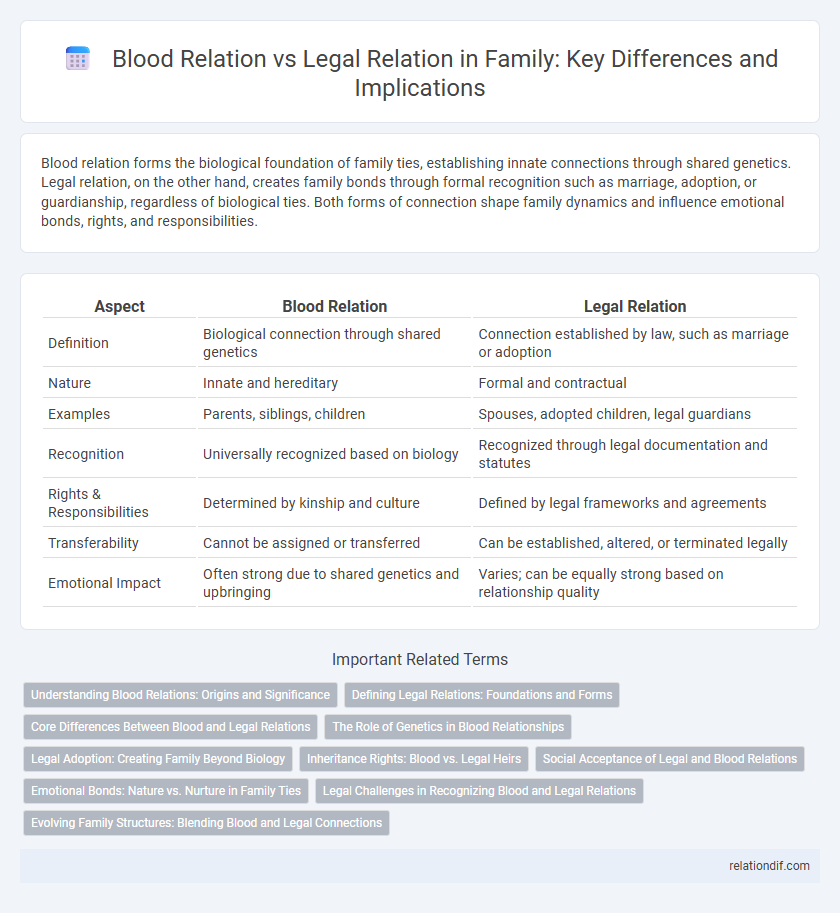Blood relation forms the biological foundation of family ties, establishing innate connections through shared genetics. Legal relation, on the other hand, creates family bonds through formal recognition such as marriage, adoption, or guardianship, regardless of biological ties. Both forms of connection shape family dynamics and influence emotional bonds, rights, and responsibilities.
Table of Comparison
| Aspect | Blood Relation | Legal Relation |
|---|---|---|
| Definition | Biological connection through shared genetics | Connection established by law, such as marriage or adoption |
| Nature | Innate and hereditary | Formal and contractual |
| Examples | Parents, siblings, children | Spouses, adopted children, legal guardians |
| Recognition | Universally recognized based on biology | Recognized through legal documentation and statutes |
| Rights & Responsibilities | Determined by kinship and culture | Defined by legal frameworks and agreements |
| Transferability | Cannot be assigned or transferred | Can be established, altered, or terminated legally |
| Emotional Impact | Often strong due to shared genetics and upbringing | Varies; can be equally strong based on relationship quality |
Understanding Blood Relations: Origins and Significance
Blood relations are rooted in shared genetics and biological lineage, tracing ancestry through DNA and familial heritage. These connections often influence inherited traits, medical history, and cultural identity, providing a foundation for family dynamics and personal identity. Legal relations, established through marriage, adoption, or guardianship, create familial bonds recognized by law but do not necessarily imply genetic ties or biological ancestry.
Defining Legal Relations: Foundations and Forms
Legal relations within families establish rights and obligations recognized by law, distinct from genetic connections inherent in blood relations. These relations manifest through forms such as marriage, adoption, guardianship, and custody arrangements, creating binding legal responsibilities and protections. Understanding these foundations clarifies how society structures family units beyond biological ties.
Core Differences Between Blood and Legal Relations
Blood relations are established through genetic connections, reflecting biological lineage and shared DNA among family members such as parents, siblings, and children. Legal relations, on the other hand, are created through formal legal processes like adoption, marriage, or guardianship, granting recognized rights and responsibilities without shared genetics. Core differences include the source of connection--biological versus juridical--and the implications for inheritance, custody, and familial obligations defined by law rather than biology.
The Role of Genetics in Blood Relationships
Blood relationships are fundamentally defined by shared genetics, which establish biological connections through inherited DNA sequences passed from parents to offspring. Genetic ties influence traits, hereditary conditions, and ancestral lineage, distinguishing blood relatives from legal relatives who may be connected through adoption or marriage. Understanding the role of genetics provides insight into biological kinship, essential for medical history, identity verification, and genealogical research in families.
Legal Adoption: Creating Family Beyond Biology
Legal adoption establishes family bonds that transcend biological connections by granting adopted individuals the same rights and responsibilities as biological children. This process involves formal legal recognition, ensuring inheritance rights, parental duties, and social legitimacy within the family unit. Adoption reshapes the concept of kinship, emphasizing commitment and caregiving over genetic lineage in defining family relationships.
Inheritance Rights: Blood vs. Legal Heirs
Inheritance rights often prioritize legal relationships over blood relations, with legally recognized heirs such as spouses and adopted children having stronger claims under most jurisdictions. Blood relatives, like biological siblings or parents, may have limited or no inheritance rights if excluded by a valid will or if legal heirs exist. Estate laws vary by region but typically favor legal heirs to ensure clear succession and prevent disputes.
Social Acceptance of Legal and Blood Relations
Social acceptance of family ties varies significantly between blood relations and legal relationships, with cultural norms often prioritizing biological connections for emotional legitimacy. Legal relations such as adoption or marriage confer recognized rights and responsibilities but sometimes face skepticism in communities emphasizing genetic lineage. Studies show that acceptance of legal family members increases in societies with progressive views on family structures and inclusivity.
Emotional Bonds: Nature vs. Nurture in Family Ties
Emotional bonds within families often transcend the boundaries of blood relation, as legal ties can foster deep connections through shared experiences and mutual support. Nature contributes genetic links that influence innate traits and predispositions, while nurture shapes emotional attachment and loyalty through caregiving and communication. Studies reveal that secure emotional bonds develop more robustly in environments emphasizing consistent nurturing, regardless of biological relatedness.
Legal Challenges in Recognizing Blood and Legal Relations
Legal challenges in recognizing blood and legal relations often arise from discrepancies between biological parentage and official documentation, complicating custody and inheritance rights. Courts frequently navigate conflicts involving DNA evidence alongside adoption papers, surrogacy agreements, or marriage certificates to establish parental responsibilities. These challenges underscore the importance of clear statutory definitions and robust legal frameworks to protect both biological and legally acknowledged family members.
Evolving Family Structures: Blending Blood and Legal Connections
Evolving family structures increasingly blend blood relations with legal connections, reflecting diverse forms of kinship and caregiving. Legal parentage, adoption, and guardianship expand the definition of family beyond biological ties, emphasizing emotional bonds and social roles. This integration supports inclusive family dynamics that recognize the legitimacy and stability of non-biological relationships.
blood relation vs legal relation Infographic

 relationdif.com
relationdif.com